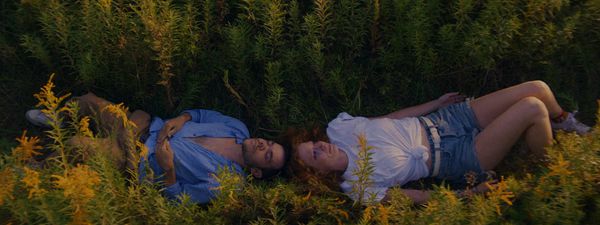 |
| Matthew Jeffers and Sarah Hay in Unidentified Objects |
The story of an introverted gay little person talked into going on a road trip by his neighbour, who is hoping to meet up with the aliens she believes abducted her years previously, Unidentified Objects is one of those little indie gems which, too often, one needs luck to discover. It’s screening as part of this year’s Inside Out festival in Toronto, and stars Matthew Jeffers and Sarah Hay, together with director Juan Felipe Zuleta, were enthusiastic about meeting to discuss it. Their easy chemistry and passion for the project shone out of them, and Sarah began the conversation by telling me how she came on board.
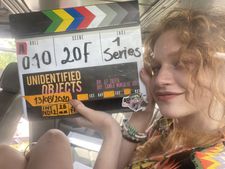 |
| Sarah Hay on the set of Unidentified Objects |
“My first time I read it – I was sent it by my manager – I was completely taken aback by the whole thing,” says Sarah. “It was just so interesting and captivating. And then I started having conversations with Juan Felipe actually kind of privately, outside of my manager, because it was a small movie and a first time feature director and I wanted to take a chance. A lot of the time in my industry, the risk is too big to take. I felt so confident about the script that I just kind of went for it. And then they had me work with Matthew and make sure that it was the right fit, and that we had chemistry and got along well. And then we just decided to roll, on Zoom. All on Zoom, because this was August 2020 that we shot the film. So we ended up having great chemistry, and I love him, so here we are.”
“Yeah,” says Matthew. “It was July 2020 that I received an audition from my agent for this weird indie film. At the time, I was going through a couple of personal challenges, I was feeling very creatively stricken, and not motivated to do anything because Covid was at the forefront of my mind. And so weeks went by before I even responded. I said like something, you know, ‘I'll look into this.’ And then two weeks later, they did a like a gentle knock on the door to see if there was any interest. And my partner was the one who was like, ‘Just send in a tape, you know, do what you do.’ And so I did, and I got a call back.
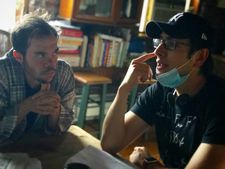 |
| Matthew Jeffers and Juan Felipe Zuleta |
“When we had the call back, it was a Zoom meeting for an hour with Juan Fe and the producers and the writer. After that meeting, I knew that this was a very unique group of young, talented filmmakers, and they just exuded brilliance and passion, which is what you want to be a part of. And I got the offer a few days later, and was overcome with a lot of self doubt and anxiety. It took me a little while to read the script because I was so intimidated. But once I got myself emotionally ready to read, I didn't sleep that night. I was so excited. So excited for the story and the team and I was just so ready to go. It was really off to the races after that.”
So how did the idea develop in the first place?
“Leland and I have known each other since 2015,” says Juan. “He’s my creative partner when it comes to cinema and filmmaking. I discovered Leland when I was an intern at Paramount Pictures, and he had a script there. It was called Sleepless. And the script was incredible. It was captivating, like thrilling. It was one of the best scripts. I was reading a script every day, or two scripts sometimes, and it was obviously hard to find something that stood out. At the time I was reading The Story Of My Life, which is now the movie Arrival, etc. And Leland’s script was extraordinary.”
They were eventually introduced outside that environment by a friend at university, he explains, and then connected properly through Facebook.
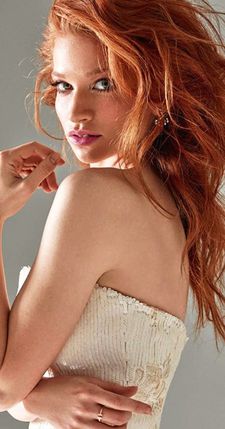 |
| Sarah Hay |
“He and I started working together on a few projects. We had a movie that we were going to shoot in 2020 in Spanish, which Leland and I developed, which we had NYU grant and a little bit of financing for, but that collapsed due to Covid. And then Leland and I were completely like, we are filmmakers. We work in filmmaking, we used to work in the advertising industry. I used to work for an agency as well. And we were unemployed at the time and we were having financial struggles, and we were really at the bottom. And in the process, we had an idea. We had discussed representation in cinema, and we had talked a lot about little people representation in cinema. And we had this idea about a little personal character on a road trip. And we found ourselves with time to work, because we didn't have anything else.
“Financially and psychologically, we were in a place where we just got our movie, that we had been working on for four years, cancelled. We sort of stood up and I just told him like, ‘We're going to make this a success.’ In five days, we wrote a 20 page treatment of the themes, and why for us the story matters. And I'm a big fan of road trip movies. I have always been. I love them Little Miss Sunshine and Y Tu Mama Tambien are two of my favourite movies ever. Like I'm a big fan of Alfonso Cuaron, one of my biggest idols. I look up to him. I just think there's something captivating about the road trip thing, but I feel like also a lot of movies get stuck because it's just a road trip – it’s very easy to just make it obvious and linear.
“I like challenges and actually just started playing. We started putting the characters in situations from a thematic standpoint and from a character standpoint, and eventually just it flew and Leland started writing five pages a day, at the beginning of June 2020. June we wrote the script, July we financed it, cast it and did pre production. August, we shot it, and I edited for a year after that. We put our entire hearts into it and it’s ultra, ultra low budget. But it came from a place almost like the world collapsing on our shoulders, the political situation in the US.”
“But it's so often the case where the most beautifully poignant stories come from moments of despair and isolation,” Matthew interrupts. “Because when you feel exposed, and when you feel lost, you feel your most vulnerable. And when you're most vulnerable, you're able to access emotions and feelings that are typically shielded.”
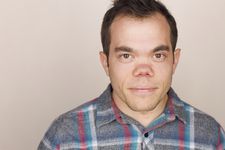 |
| Matthew Jeffers |
“Matthew was the first person we brought on board,” says Juan. “We brought him on as collaborator on the story and he gave us a lot of information. And he became rapidly, almost like part of our writing team and producing team from a standpoint of like, ‘Yes, I give you permission to tell this. No, this should be this way.’ So together, organically, it became a very nice creative environment, and in a time where we were all incredibly helpless about our future.”
Matthew nods. “I think a big a big word that really has echoed throughout this process for me, is trust. I love this team for so many reasons, but one of the reasons that's pertinent to what Juan Fe just brought up is that it was a culture from day one of trust on all sides. You know, there were no egos, it was just trust in the people and trust in the story. It created a very strong linkage of people who were financially and emotionally invested in this tiny little story that we that we wanted to tell – a real, true collaboration. It’s rare in this industry to feel that way, from what I've experienced so far, so I really believe that that's what people see on screen. I think that's why it's so infectious to watch”
I venture that, in terms of representation, I find that often films which are using quirky humour will throw in little people as ‘quirky’ characters just to try and add colour to the film. And in this, it’s people's prejudice and people's old reactions, perhaps things that they haven't even examined, which become a source of humour, so we’re laughing at that behaviour rather than at individuals.
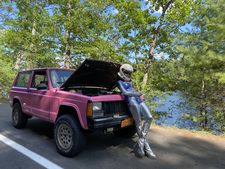 |
| These are not the aliens you're looking for |
“One million percent,” says Juan. “Leland and I are in many ways like academics. We love movies, we watch a lot of them, we care a lot about representation in cinema. Even if you go back to like, historically, if you look at the earlier Sidney Poitier movies, when black people were looked down upon in cinema, they literally brought that to the foreground and made us aware of the racism that was going on, so that people in the theatre could feel uncomfortable knowing that they had those prejudices. I'm an immigrant in the US as you know, I have an accent. Having people at agencies and production companies I work with say things like, ‘Oh, he has a funny accent. Jose! What is your name, Jose? Juan? Jorge?” He shakes his head.
“We wanted to make something authentic and unique. And Leland is also a dramaturgist. It came from bringing that to the foreground, but also like, making people feel uncomfortable and aware at the same time – without pointing fingers but bringing it in a smart, humorous way.”
There are obviously other issues going on with Sarah’s character, who is bubbly on the surface but as a real underlying fragility. Whether she’s delusional or has been treated as delusional because of her beliefs, it’s obvious that she’s vulnerable.
“I think there's a kind of innocence in her, regardless of what she chooses to do with her life, that's kind of delicate,” says Sarah. “And there is a piece of all of us, I think, that is childlike intuition and hope and dream. I wouldn't say that she's completely delusional, I think she's just in a sort of a desperation that makes her feel a little bit hopeless. And the hope that this dream could actually be real is kind of keeping her going.”
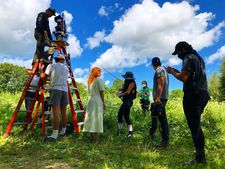 |
| Prepping for a shot |
I ask Matthew if he found it challenging to play a more low key role opposite a character as big as that, and he credits her with doing a lot of the work, giving him something to react to.
“ It was beautiful. They were very much these two bubbles that kind of kept bumping into each other. The audience wonders which bubble will burst first, which of these characters living on the wire will explode first, because they very much butt heads.”
“I was purposefully being large, in a sense, because I needed to force him out of his comfort zone – to force his character out of his comfort zone,” says Sarah. “So at a certain point, it kind of started like this.” She holds up her hands, the right one above the left, and slowly moves her right hand down and her left one up. “They met in the middle somewhere. And then my character went way down and started tanking, you know, and then there, they meet back in a certain way.”
Juan nods. “If I were to offer something about working with both of them, I feel like you can tell in movies, no matter the budget, when an actor trusts the director, or trusts the other performers and trust the process, when they're truly invested. And there's true commitment. With working with them, it was very interesting, because I feel like the best way to give him direction was telling her to pinch him, and the other way around. So it was a lot of fun because they were so invested, and the way they got under each other's skin. And they took it so seriously. And then they were both like, in that constant push back and forth. With Winona, it's just like encapsulating personality that is charming. And she always gets away with whatever she wants, no matter what. And Peter being intellectual, but poor with emotional intelligence, in some ways. Both have their strengths and weaknesses and their own secrets. We all took it seriously, but it ultimately comes down to the commitment they had to just going all in and trusting and building character.”
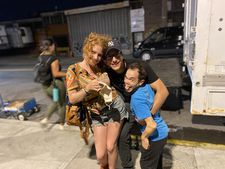 |
| Fun on set |
We discuss the challenges of shooting on a low budget, with Covid precautions to factor in as well. Sarah describes it as a 19 day shoot but Juan says that most of the team was only shooting for 15 days, whilst he used the other days to capture drone footage.
“Basically, on the weekends when everybody had time off, I shot the drone shots, The crew that we had was incredibly committed to telling the story. It would have been impossible to tell it if it wasn't with people who really loved and believed in this. It was very hard process.”
“I was asked recently what what I've learned, what were the main like takeaways from from from filmmaking on this on this budget and in this way,” adds Matthew. “Juan Fe planted this idea in my mind very early on and then I saw it come to fruition as we shot: at this budget you need a thousand mini miracles to go your way for the film to come out the way you want it to come out. It's just so true. Looking back, there's so many. So many little miracles that happened each day on set that mostly went our way, which is why the film looks so beautiful.”
By way of example, he references a key scene near the end of the film.
“ Just in the hour that we shot, this gorgeous early evening mist came through this field. Watching it on screen, it provides this whole layer of texture, of mood, a surreal quality, because this fog is right as people are coming out of nowhere. Would it look great if that texture was not there in the background? Yeah, but you see it and it's just it's one of those things. We didn't have fog machines going in the back. It was so natural. A lot of the sunsets were just gorgeous, like we only had that day could have been overcast. We just got very, very, very lucky.”
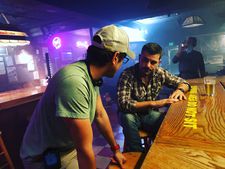 |
| Propping up the bar |
“We were one of the first projects, if not the first project to get greenlit by SAG-AFTRA on the East Coast,” explains Juan. “And we had zero Covid cases during production. Massive movies like Mission Impossible with massive Covid protocol budgets had to break production. At the time the protocol was we had to test three days a week for main performers and people in the small circle, which is the actors and basically me and the cinematographer. And then the rest of the crew was twice a week or something. It was brutal. Every time the nurse came to the set and tested everybody, it was nerve wracking because if one positive case came, we don't have any backing from anybody. This is funded by friends and family and people we know . This is not like a studio movie or anything.”
Nonetheless, the finished film exceeded his expectations.
“One thing about moviemaking which is interesting is when you put everything you are into something that you love, and you pour in all your heart and your passion, you discover something that you cannot write. And that comes through bringing the brains and the passions of your collaborators. I think, like, the cinematography, I imagined that it would be beautiful, but I think what Camilo [Monsalve], our cinematographer, did is extraordinary. I think it's top level. The cinematography of our movie, even at the budget that we have, is extraordinary. As a director, I was willing to shoot with, like, lesser lenses or cameras, but we were blessed by Panavision supporting us and saying ‘We believe in the story, go do it.’
“Bringing the right actors, I was ruthless about that decision. I was not going to make the production if I didn't have the right people. Finding the right people in a timely manner and having them be incredibly kind human beings by like trusting me, and during Covid...and they didn't know who I was! I shot the movie when I was 26 years old. I did pre production when I was 25. Who was going to trust me to shoot this movie?”
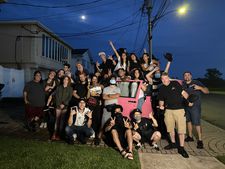 |
| The gang's all together |
He also got support in the editing stages from a big producer, he says, and it’s clear that alongside the practical help all this brought, he was really buoyed up by all these voices of support.
“Ultimately, I proved to myself that it's not about you thinking that you're really good. It's about being ruthless, putting the work in and, most importantly, finding the right people. A movie is a product of the average of the people working on it. You could have the best performance but if it's not well shot, or if the script is really weak – even though I do think acting adds a lot, but all the elements matter. I do feel like we took that incredibly seriously and I'm very proud of the final product. I feel I gave my absolute best, and I feel proud of that.”
They’re all excited that the film is screening at Inside Out.
“This is my first queer Film Festival,” says Sarah. “I've attended OutFest in Los Angeles, but I've never had a film participate in one, and the reception from the people who have seen it and just the energy of the place has been so lovely and exciting. And I am just a full advocate for being different and expressing yourself the way that you would like to, and not letting other people tell you that you cannot – unless you're hurting people.” She laughs. “So I'm just surrounded by love and it's the most exciting festival I've been at, and I've had movies at much larger festivals, you know? This one feels like the right one.”





















